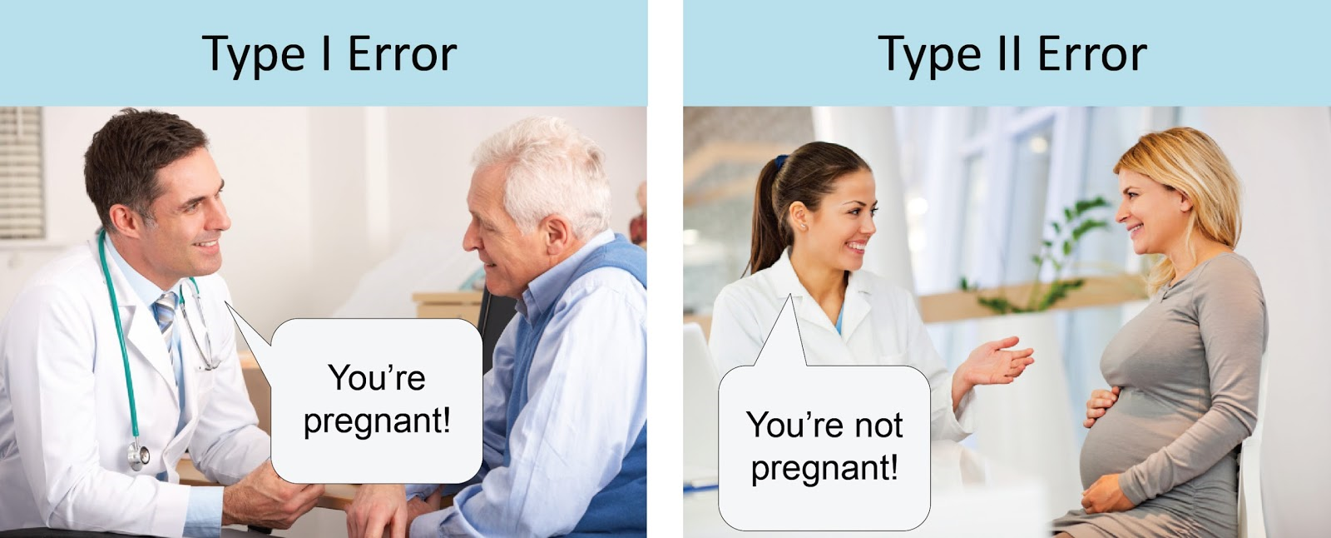8.1 Hypothesis test
Definition
Hypothesis: a statement about a population parameter.
- The mean height for an adult male is 5’9”.
- The drug lowers patients’ blood pressure.
- Record the heights from 20 people, the sample mean is 5’7”.
- Not a hypothesis
- Simple hypothesis
- The parameter takes a single value (e.g., \(\mu=8\)).
- Composite hypothesis
- The parameter takes more than one value (\(\mu > 8\)).
Null hypothesis \(H_0\)
The statement that is initially assumed to be true.
- It is the default (or “favored” or “protected”) hypothesis that we stick with unless evidences are strongly against it.
- It usually states that nothing “interesting” is happening.
- The drug has no effect on blood pressure.
- The coin is fair.
- A criminal trial analogy: “Innocent until proven guilty”
- \(H_0\): The defendant is innocent.
Alternative hypothesis \(H_a\)
- It is the hypothesis that is contradictory to \(H_0\).
- It states something “interesting” is happening.
- The drug lowers patients’ blood pressure.
- The coin is biased.
- The defendant is guilty.
- The burden of proof is placed on the alternative hypothesis.
Hypothesis testing
- Many scientific questions can be boiled down to a simple yes or no:
- Is something “interesting” happening, or not?
- Is the new drug effective (\(H_a\)) or not (\(H_0\))?
Hypothesis testing: A method to decide whether we should reject the null hypothesis (\(H_0\)) or not based on data.
The two types of errors in hypothesis testing
\(H_0\): the person is not pregnant.
| Fail to reject \(H_0\) | Reject \(H_0\) | |
|---|---|---|
| \(H_0\) is true | Correct | Type I error (false alarms) |
| \(H_0\) is false | Type II error (misses) | Correct |

| Fail to reject \(H_0\) | Reject \(H_0\) | |
|---|---|---|
| \(H_0\) is true | Correct | Type I error (false alarms) |
| \(H_0\) is false | Type II error (misses) | Correct |
\[ \small{ \begin{aligned} \text{P}(\text{Type I error})&=\text{P}(\text{false alarm}) \\ &=\text{P}(\text{reject $H_0$ when it is true}) \\ &=\alpha \\ \text{P}(\text{Type II error})&=\text{P}(\text{misses}) \\ &=\text{P}(\text{fail to reject $H_0$ when it is false}) \\ &=\beta \\ \end{aligned} } \]
Type I vs. type II errors
- In many cases, a type I error (false alarms) is often more serious than a type II error (misses).
- Criminal trial
- Type I error: Innocent person wrongfully convicted.
- Type II error: Guilty person going free.
- Drug testing
- Type I error: Approving a drug that does nothing.
- Type II error: Not approving an effective drug.
Significance level
- In practice, we often specify the largest value of \(\alpha\) that can be tolerated.
- The resulting \(\alpha\) is called the significance level.
- Common significance levels \(\alpha=0.05, 0.01, 0.001\).